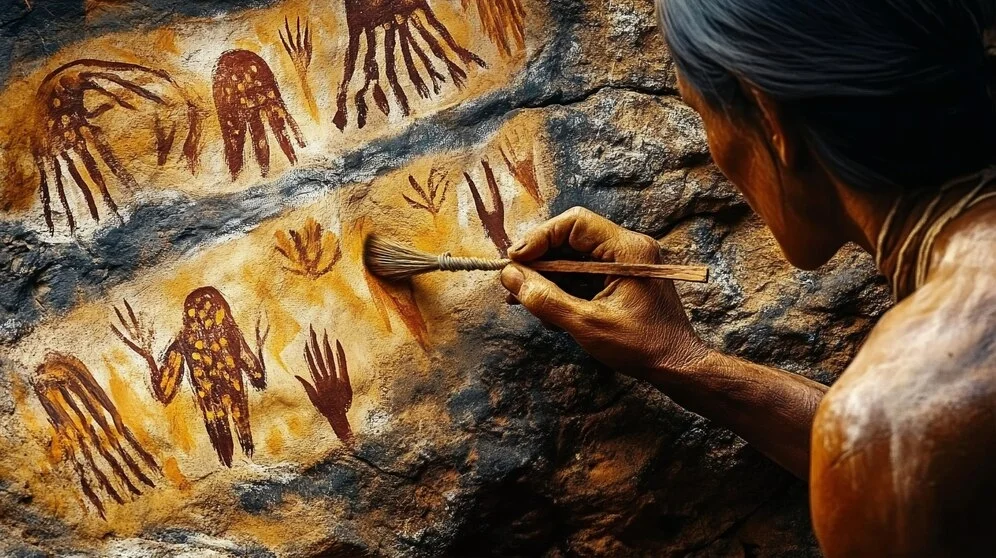Long before written language, before cities rose and rulers reigned, humans were already telling their stories—through what we now call Ancient Artz. Whether etched onto cave walls, painted with red-ochre, or carved from bone, these early expressions of creativity are among the most powerful links we have to our prehistoric ancestors.
A Journey Into Ancient Civilisations
The story of Ancient Artz is the story of humanity’s development—from the Paleolithic period to the Iron Age, from nomadic hunter-gatherer tribes to complex ancient civilizations like the Harappan, Sumerian, Mesopotamian, and Ancient Egyptian societies. These cultures left behind stunning art sites, sculptures, figurines, and monuments—testaments to their spiritual lives, everyday activities, and social hierarchies.
The Roots: Paleolithic Rock Art and Symbolism
Some of the earliest-known examples of Ancient Artz are the breathtaking cave paintings and petroglyphs scattered across the globe. From Altamira in Southern France to Sulawesi in Indonesia, these prehistoric times saw the emergence of figurative and naturalistic artwork that still fascinates archaeologists and anthropologists today.
In the Chauvet Cave, for example, images of bison, mammoths, and horses—some over 30,000 years old—are preserved in charcoal and ochre, evidence of the artistic spirit of early modern humans and Homo sapiens. Hand stencils, engravings, and rock-art suggest not only artistic intent but possibly shamanistic or ritualistic functions.
Artistic Evolution: From Survival to Spirituality
As societies evolved, so did their works of art. The Neolithic Revolution introduced domestication of animals and plants, which allowed communities to settle and build megalithic structures like Stonehenge. With this came more complex aesthetics, pottery, and symbolism.
In Harappan cities, found at major archaeological sites across the Indus Valley, we see sophisticated stone tools, plaster figurines, and carvings that reveal deep understanding of geometry and urban planning. Artifacts from these sites, now displayed in leading art museums, show a people who valued order, beauty, and possibly even portraiture of their rulers or priests.
The Middle-East, especially the Near-East, was another cradle of creativity. The Sumerian and Mesopotamian civilizations produced stunning polychrome reliefs, temples, and pyramids long before the Old Kingdom of Ancient Egypt would raise the Great Pyramid of Giza.
Art as Power and Legacy
In Ancient Egypt, art sites and tombs tell us how closely art was tied to power and religion. The Pharaoh was not just a ruler but a divine being, and every statue, engraving, and mural depicted this truth. These societies understood aesthetics as a tool of influence, creating dynasties that lasted millennia. Much of this art was carved from limestone and covered in vivid red-ochre and charcoal—materials that still resonate with curators in today’s museum of art exhibitions.
In the Mediterranean, Ancient Greece and Romans added their own flavor to Ancient Artz, emphasizing human form, movement, and mythology. The Renaissance would later be shaped by this classical tradition, creating a rich chronology of art history.
Hidden Art and Emerging Discoveries
While many well-known archaeological marvels have long been excavated, new discoveries continue to reshape our understanding of ancient history. Archaeologists still uncover figurines, burials, statuary, and even entire chapels hidden under sand, ice, or jungle—preserved for thousand years.

Radiocarbon dating and fossil analysis have helped clarify the emergence of symbolic behavior in early humans, including the Homo erectus and Neanderthals. Some archeologists argue that prehistoric art even predates anatomically modern humans, offering insights into human evolution and cultural development in the last ice age.
Cultural Context and Spiritual Meaning
Many of these early creations likely held religious or ritualistic value. Some paintings and engravings appear to show shaman figures, celestial events, or biblical narratives. In Upper-Paleolithic Europe, the Venus figurines suggest fertility worship. Meanwhile, paintings in caves show elaborate hunting scenes, indicating the importance of hunting and gathering in early societies.
The Chapel-like sanctuaries in Altamira or Iberian shrines reveal art’s central role in prehistoric spirituality. Some art sites even contain burial chambers, possibly used for complex rituals and ancestor veneration.
Museums and Modern Appreciation
Today, Ancient Artz is on display in major institutions around the world—from the British Museum to the Louvre, the Met, and UNESCO-recognized World Heritage art sites. Curators, painters, and even digital artists draw inspiration from this timeless imagery.
In fact, Picasso himself once said, “After Altamira, all is decadence.” The emotional, raw, and mystical quality of these early creations continues to impact how we see ourselves as creators.
Conclusion: More Than Just Art
Ancient Artz is not simply about looking at pretty statues or colorful cave drawings. It’s about understanding how humans made meaning of the world. From prehistoric times to the heights of ancient civilization, art was never separate from life—it depicted survival, belief, power, and imagination.
Whether carved in ivory, painted on a wall, or molded from clay, each piece is part of a grand outline of human history. As we look back over the millennia, these visual records remind us that creativity, emotion, and curiosity have always been part of what makes us human.
So next time you walk into a gallery or stumble across an art site, think about the hands that made those marks—maybe in a cave, with a spear laid beside them. Maybe by a fire, using charcoal and spit. Maybe dreaming of spirits, gods, or stories. They were people, just like us. And their art, the original Ancient Artz, still speaks.
Read More: The Ultimate Guide to Unblocked Games 76: Your Gateway to Fun Without Restrictions
